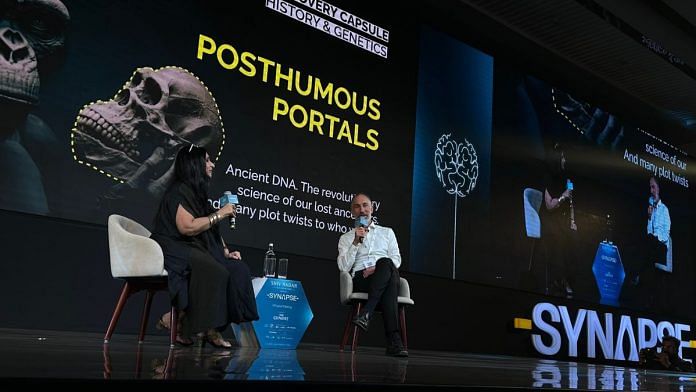New Delhi: Despite years of evolution and racial intermixing, modern man still has traces of ancient humans—Neanderthals and Denisovans—according to American geneticist David Reich. These traces, he said, continue to impact factors like how susceptible modern man is to disease or how the body responds to external factors.
Reich, a professor of genetics at the Harvard Medical School, was a guest speaker at Synapse, a global AI conclave in Gurugram founded by journalist Shoma Chaudhury.
“If you look at the DNA of non-Africans, you will still find around two percent traces of the Neanderthals and the Denisovans. These traces impact so many traits even today,” Reich said Saturday.
He said that it was found that, among the Tibetan population, their ability to adapt to high altitudes came from the Denisovans. Similarly, it was also found that among South Asians, there was a higher susceptibility to COVID-19 because of traits from the Neanderthals.
Reich is one of the world’s most eminent analysts of ancient human DNA. In 2006, his study showed that after the human and chimpanzee lineages diverged from a common ancestor, interbreeding continued for perhaps a million years before a final split.
The findings of this study led to the major discovery in 2010 that modern humans had mated with the ancient lineage.
“Ancient DNA is like a time machine. It takes you back in time to the people whose bones you are discovering from cultures of the past. And it is a great way to get answers to our origins,” Reich said.
Also Read: Tinier arm shows scientists where early humans’ ‘Hobbit’ cousins came from — Nature study
Unlocking origins of Hindi, Sanskrit
Reich’s latest work has now unlocked the origins of the Indo-European family of 400-plus languages, including Hindi and Sanskrit. These are spoken today by around 40 percent of the population around the world. The study, published in the international journal Nature on 5 February, said DNA evidence shows that these “linguistic pioneers” came from current-day Russia during the Eneolithic period (Copper Age) about 6,500 years ago.
It was found that these populations were spread across the steppe grasslands along the lower Volga river in Russia to the northern foothills of the Caucasus mountains in the intersection of Asia and Europe.
Researchers have dubbed them the Caucasus Lower Volga people. Genetic results show they mixed with other groups in the region, Reich’s team concluded in the study.
During the course of the study, researchers noted similarities among the far-flung languages of Latin, Greek, and Sanskrit in the late 18th century. The first similarities among the far-flung languages of Greek, Latin, and Sanskrit were studied in the late 18th century. The ‘steppe hypothesis’, formulated during the 19th century, suggested that speakers of the ancestor language of the Indo-European group lived on the Eurasian steppe
In the latest study, scientists drew on linguistic reconstructions and archaeological evidence to place them in an area where Russia and Ukraine stand today. The Yamnaya people, a group of herders who migrated from the eastern Steppe region to Europe around 5,000 years ago, emerged as the leading contenders for the language family’s originators.
(Edited by Sanya Mathur)
Also Read: Why do Europeans have lighter features than their ancestors? Italian scientists have solved mystery






